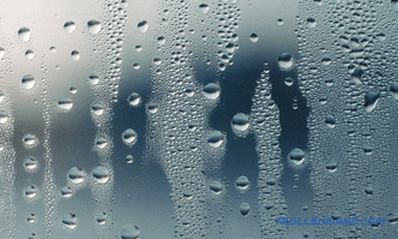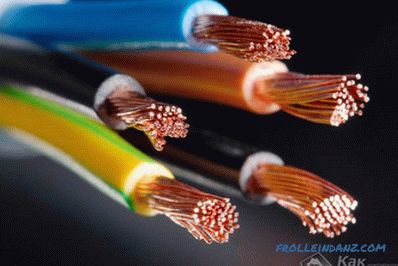The quality of modern drinking water, regardless of the method of its delivery, leaves much to be desired. This concerns not only the central water supply, but also well water, and even artesian wells. In most cases, the problem with pollution of various kinds can be solved using filters. This article will discuss the different methods of filtering, how and what filter to choose for water purification, when it is expedient to use and when it is not recommended. General selection criteria and operational features of the equipment.
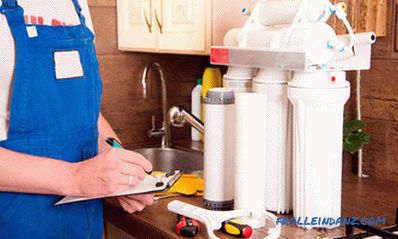
Water purification methods
Modern models of household filters have different principles of operation. Their design, active substances, the presence and location of filter elements vary significantly. Before proceeding to the selection of a filter, it is necessary to understand what methods of water purification exist and how they affect the quality of water.
Mechanical cleaning
Mechanical cleaning is used to remove solid impurities from water - sand, rust from pipes, as well as various salts and chemical additives.
The following types of mechanical filter elements are distinguished:

Mesh - mesh is used as the main element, size cell which depends on the level of water pollution and is 20-500 microns.
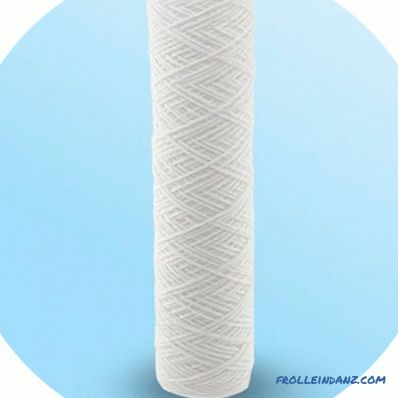
Of the synthetic fibers , a rope or a rope that retains coarse dirt is wound onto the mesh cylinder. In the process of cleaning and accumulation of harmful substances, the material changes color.
Sorption cleaning
The principle of operation is based on the phenomenon of adsorption — the retention of microparticles of contamination by the external surface of filter solids. The active substance, as a rule, is activated carbon. Budget models are equipped with cartridges containing wood (birch) activated carbon. More expensive and effective cartridges are filled with activated carbon from coconut shell, which has an adsorption capacity of 4 times higher.
The main purpose is to remove various organic compounds and residual active chlorine, as well as odors associated with these substances. The filtering elements, consisting exclusively of coal, have a limited spectrum of action; ion-exchange substances are added to the cartridge to expand it. Combined cartridges will be able to remove herbicides, pesticides, asbestos particles, oil products, heavy metal ions.
By adsorbing organic matter, carbon filters can be a breeding ground for bacteria to grow, so they can be used to clean pre-disinfected water. Restoration of sorption filters at home is impossible and after exhaustion of their limit, they must be disposed of.
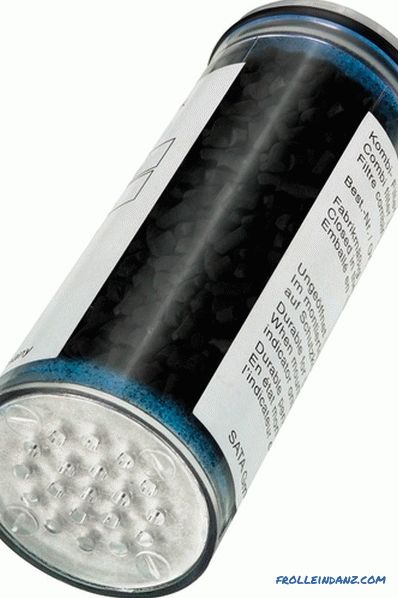
Cartridges with coal sorbent
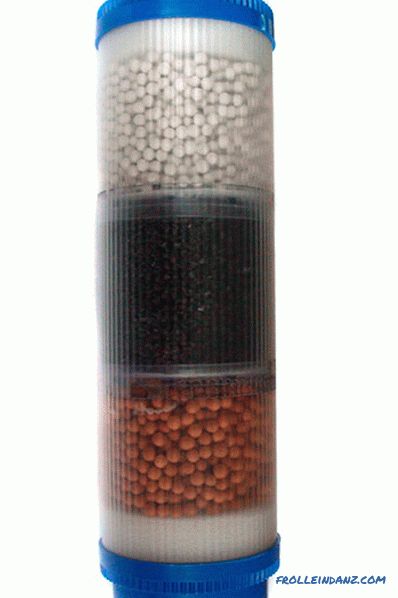
Cartridge with a combined sorbent
Ion-exchange cleaning
Ion-exchange filter elements are rarely used as independent devices. They are an integral part of multi-component household cleaning appliances. The main task is to reduce water hardness. It is performed due to the ion exchange (substitution) reaction, which is based on the binding of calcium and magnesium ions in water into insoluble complexes. As an active element, special synthetic resins with alkali metal salts: potassium and sodium are used. It is these elements that react with the hardness salts (calcium and magnesium) and hold them.
There are two types of ion exchange resins, anionic and cationic. They bind salts of hardness due to different types of chemical reactions, but in the course of their operation for the average consumer the difference is almost not noticeable. Most ion exchange resin cartridges can be rebuilt at home. It is enough to rinse them with a strong solution of table salt so that the substitution back reaction occurs.
IMPORTANT! After the ion filter, water must be cleaned with a carbon filter without fail.
The main disadvantage of the ion-exchange purification method is the small resource of functioning before the recovery process. Depending on the model, it can be from 200 to 800 liters.
Purification with reverse osmosis membranes
Many water filter vendors call combination devices that combine ultra-fine purification devices for ultra-fine cleaning devices. This is not true. Ultra-thin cleaning involves filtering water using membranes. With ultrafine cleaning, water under pressure (in some models up to 6 atmospheres) is fed to a membrane filter with a pore size of 0.0015 to 0.1 micron. As a result of this cleaning, all harmful impurities remain on the membrane surface, and only water molecules pass through the membrane.Recently, with the development of nanotechnology, hollow fiber capillary membranes have begun to be applied. Their use significantly reduces costs, both for the maintenance of the treatment plant and its cost.
Ultrafiltration allows you to remove mechanical impurities, organic matter, colloidal silicon, excess iron and manganese, and to carry out almost complete disinfection of the liquid. The main disadvantage of this method is the relatively high cost of installation and the need for continuous monitoring of the state of the filtering membranes and their systematic washing and / or replacement.
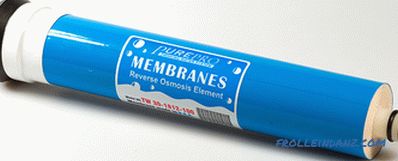
Module with a reverse osmosis membrane installed.
Electrochemical Purification
The electrochemical method of purifying drinking water is used in household filtering devices in conjunction with other methods. The main objective is to improve the physicochemical and organoleptic properties of drinking water.
Settings have a rather complex structure consisting of:
1. Electrochemical reactor;
2. Slag collector - for most models it is installed in the upper part of the device;
3. A floating cone-stub blocking the upper opening.
4. Electrode block containing three groups of electrodes:
- І and ІІ groups form an electrocoagulating pair package;
- ІІІ - consists of electrofloctation electrodes.
5. Switching device - redistributing positive and negative charges of energy to the cathode and anode packages of electrodes;
6. Some models have final filters.

Household water electrolyzer.
UV - disinfection
Modules for water disinfection by ultraviolet irradiation are used in conjunction with other filtering methods. The principle of operation is based on the treatment of water flow with intense UV radiation in the wave range of 250-260 nm. This radiation penetrates the cell walls of viruses and bacteria, causing the destruction of the body's DNA and RNA.
This method is much more efficient and safer for human health than the classical reagent method, in which water is treated with various oxidizing agents: chlorine, chlorine dioxide, sodium hypochlorite, etc. The scope of the UV disinfection unit is related to its rather large dimensions and high cost. Typically, these are cottages, cottages and buildings that use artesian wells or autonomous wells for the water supply system.
The UV module consists of the following key elements:
1. Power supply;
2. Metal case;
3. The source of UV radiation:
- Mercury-quartz lamp;
- Mercury-argon lamp;
4. Protective (hermetic) quartz casing - prevents overcooling of lamps with a stream of water.
Depending on the declared performance, several UV lamps can be placed in one package. The main disadvantage of this method is its complete energy dependence. Also for efficient operation it is necessary that the incoming water was of a certain quality, its physical and chemical indicators should not exceed:
- Turbidity. 2 mg / l;
- chromaticity. 20 °;
- The content of iron impurities. 1 mg / l.
In which case it is possible to use one or another type of water filter
The efficiency of cleaning devices depends on which water filter to choose in each particular case. Modern manufacturers produce a variety of models of various cleaning devices and water filters. Many of them do not have any particular benefit, and sometimes, if improperly installed or the conditions are violated, are a source of biological contamination.
Dirt filters
A sump refers to the means of mechanical water purification. It is a device in which there is a forced change in the direction of water movement. The stream passes through a special grid, leaving solid contaminants on it.
The sump consists of:
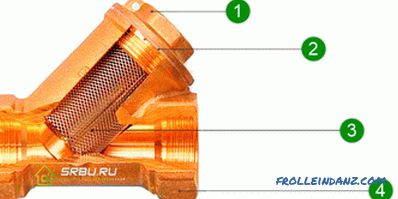 The structure of the sump: 1. Brass cap; 2. Teflon or silicone sealing gasket; 3. Stainless steel filter mesh - AISI 316; 4. Case - usually nickel plated brass CW617N.
The structure of the sump: 1. Brass cap; 2. Teflon or silicone sealing gasket; 3. Stainless steel filter mesh - AISI 316; 4. Case - usually nickel plated brass CW617N.
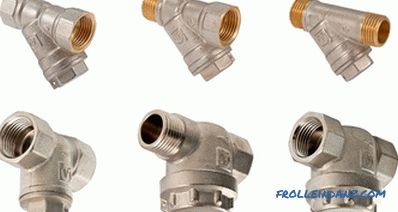
The most common household models with different types of threads for mounting:
VT. 192, VT. 191, VT. 190
VT. 385, VT. 387, VT. 388
Expediency of use. Given the characteristics of the material, mud pads can be used for pre-filtration of both cold and hot water with temperatures up to 150 ° C. They are installed at the entrance to the water supply system of the apartment or house, immediately behind the valves (tap). One of the purposes of this filter is to protect water meters from ingress of large mechanical impurities.Thinner cleaning they can not produce.
IMPORTANT! It is necessary to carefully monitor the installation direction of the device relative to the flow of water, usually it is indicated by an arrow on the body.
Prefilters
For water entering the apartments and houses from the centralized water supply, the main types of pollution are:
- Excessive active chlorine;
- Organics;
- Oxidized iron (from worn-out pipelines).
To purify drinking water from solid impurities, which not only significantly impair its taste, but can also damage household appliances (washing machines and dishwashers), prefilters are used.
The design consists of:
- Mounting bracket;
- Plug connections for connection to the water supply system;
- Cases transparent plastic;
- Replacement filter cartridge made of synthetic fibers.
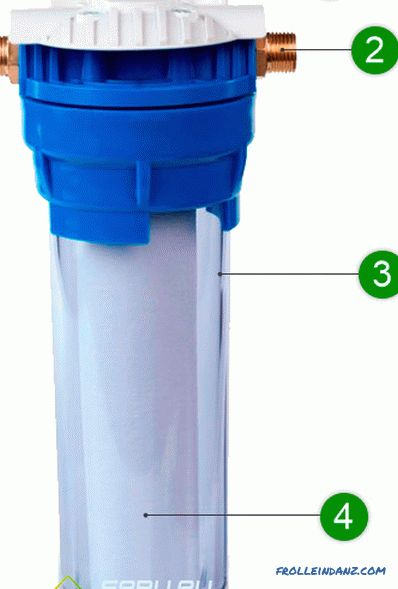
Expediency of use. Prefilters should be used in cleaning systems if the water entering the house has a significant content of solid impurities. The choice of a particular model depends on the average water consumption. Used to protect gas boilers and columns, as well as washing machines and dishwashers, from ingress of large mechanical impurities. In fact, they perform the same functions as mud traps, but have a greater degree of purification, size, filtration rate and resource.
Jug filters
This type of filter is widely known, usually a jug filter consists of the following elements:
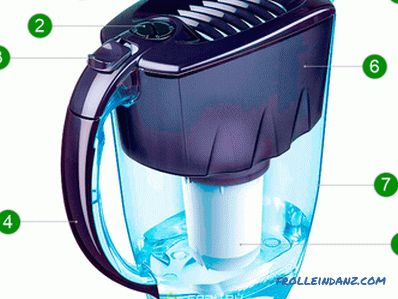
Jug filter design: 1. Lid ; 2. Calendar filter replacement; 3. Locking latch; 4. Handle; 5. Spout for draining purified water; 6. Capacity in the form of a funnel for the gulf of water; 7. Housing; 8. Replaceable filter cartridge.
Expediency of use. Jug filters are used as an alternative device for the purification of drinking water, if the apartment water supply is not equipped with stationary purification devices. The degree of their cleaning is somewhat worse, however, the cost is incomparably cheaper, which made these filters very popular. Despite a slightly worse degree of purification, using these filters, you can get water suitable for drinking. Filter jugs are equipped with different types of cartridges, which are selected depending on the contaminants present in the water.
Dispensers (Purifiers)
Conventional, budget models of dispensers using purified bottled water do not have filters at all. But the more expensive devices that connect to the centralized water supply (coolers) have their own cleaning system.
Appearance and layout of a universal office dispenser with a filtration system:

It consists of: 1. A mechanical cleaning filter that removes solids particles up to 5 microns; 2. A carbon sorption cartridge that removes excess chlorine and organic matter; 3. Ultrafiltration membranes, bacteria-removing viruses and excess dissolved salts; 4. Coal postfilter to remove unpleasant odors.
Expediency of use. Dispensers are water metering devices that are mainly used in offices.
Nozzles for the crane
Filter nozzles for the crane are mainly related to mechanical cleaning devices. They are divided into devices, mounted directly on the mixer or stand-alone.
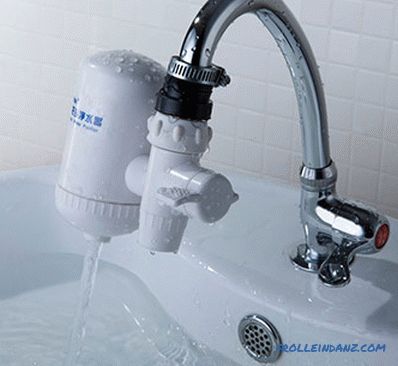

Their main disadvantages are:
- Poor quality water filtration;
- Reduced flow rates, most manufacturers produce models with a recommended speed of 1-1.5 l / min. ;
- Minor resource, for filters of "fine" cleaning it is 300-350 l.
Expediency of use. The use of such devices is recommended only in the most extreme cases when it is not possible to install a stationary purification system, and the water quality is very poor. In all other cases, the use of filter nozzles on the crane is impractical.
Flow-through sorption filters
Flow-sorption filters are a multi-stage filtration system consisting of 3-5 replaceable cartridges, each of which performs water purification from a particular type of contamination. They are optimal in terms of price - quality cleaning. Recommended for use with small and medium volume consumption of purified water.
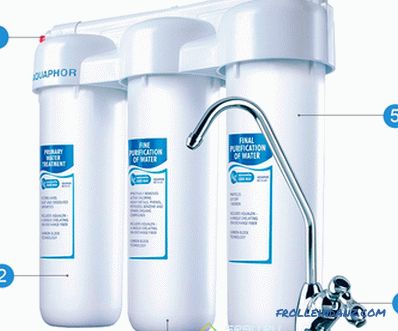
Device of the main components of the flow-through filter: 1. Water connection unit; 2. Filter prior sorption or mechanical cleaning; 3. Filter of deep sorption purification; 4. Knot for connection of the crane; 5. Finishing filter and air conditioning; 6. Crane.
* (The set of filter modules will depend on the specific filter model).
Expediency of use. Typically, these systems clean mechanical solids, active chlorine, iron, limestone, and other chemical contaminants. When choosing a particular model, it is necessary to take into account not only the prevailing type of water pollution, but also the daily consumption rate. Most models are equipped with a separate faucet, so that domestic water does not undergo filtration, this further increases the service life of the filter cartridges. It should be remembered that the use of such systems for cleaning too hard water is not advisable due to the very low resource of the ion-exchange cartridge. After exhaustion of a certain resource, water will cease to soften and the scum will appear again in your kettle. To solve the problem of too hard water is possible only with the help of reverse osmosis systems, which will be discussed further.
Reverse Osmosis Systems
A reverse osmosis system is a balanced set of devices and filters for cleaning.

Device of the main units of the reverse osmosis system: 1. Mineralizing filter; 2. Post-filter for air conditioning; 3. Module with reverse osmotic membrane; 4. Accumulative capacity; 5. Filter mechanical cleaning; 6. Filter for sorption cleaning; 7. Sorption filter for finishing cleaning; 8. Crane.
* (The set of filter modules will depend on the specific filter model).
It consists of the following components:
1. Pretreatment unit, which includes mechanical, sorption and ultrathin filter.
2. Block with reverse osmosis membrane. The membrane consists of a polymer with a pore size of 1-15 angstroms for high-purity devices and 10-70 angstroms for nano-filtration systems.
REFERENCE: 1 micron is 10,000 angstroms.
3. Storage tank. Since the speed of water purification using the reverse osmosis method is rather low, a capacity for storing filtered water should be provided in the system. The volume of the tank must be chosen in accordance with the daily consumption of drinking water.
4. Post-filter - installed after the storage tank to eliminate unpleasant odor and taste.
5. Shut-off and connecting fittings. Given the low rate of purification by reverse osmosis, it is impractical to use filtered water for domestic needs, it is mainly used for cooking and drinking. Therefore, the system must have a separate tap.
Water softeners
The process of water softening consists in reducing the amount of hardness salts, mainly chlorides and sulfates. For this purpose, replaceable cartridges with cation-exchange resin are used, which adsorb salts from water, giving in return hydrogen and sodium ions. The use of soft water is not only good for health, but also maintains household appliances. Produce such filters of different performance.
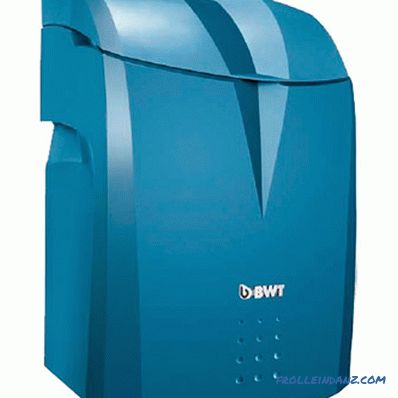
Example of a softener for drinking water.
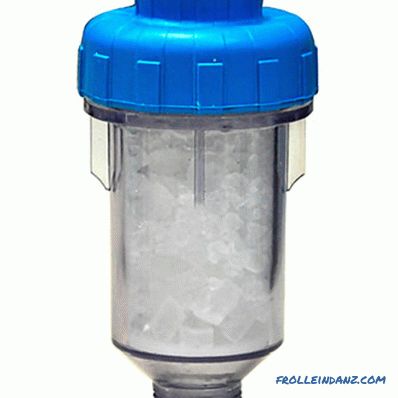
Softener to prevent scale in the washing machine.
Expediency of use. Before purchasing and installing a cation-exchange resin filter, check the level of water hardness. It is advisable to use softening if the water hardness index is higher than the recommended 1.0-2.0 mEq / l. It is also important to know that such filters do not purify water from metal salts and bacteria, their purpose is to soften water, which contains a large amount of hardness salts. If water is supposed to be used for drinking, then it is worthwhile to take care of the presence of sorption filters used to purify water from other harmful impurities. If you intend to use a softener to protect washing machines from scaling, then one softener will suffice.
Results. If you want to get really high-quality water for cooking products, tea, coffee and just drinking water, then you need to look in the direction of flow sorption filters and reverse osmosis systems. No nozzles and jugs can replace them. It should be remembered that these systems are much more expensive. If you can not afford to install such systems, then as an option, you can use a filter jug with a specific cartridge.
Post-filters
Post-filters are used in reverse osmosis systems and sets of in-line filters to eliminate unpleasant odors and improve the taste of purified water. The active element is granulated or powdered activated carbon in a polymer case. Placement of fittings for connection depends on the specific model and to which device the filter will be connected.In addition, mineralizing filters are used in reverse osmosis systems. Since after passing through the orato-osmatic membrane all useful minerals are removed from the water, such mineralizers are used to restore them. They restore the natural mineralogical composition of water.
Criteria for selecting a filter for water purification
Determining water pollution
The effectiveness of the purification system used, therefore, the quality of the filtered water depends on the specific pollution. Before determining which water filter to choose for a house, it is necessary to carry out a comprehensive analysis of the water coming from the water supply system. The analysis needs to be done regardless of whether the well, artesian well, or centralized water supply goes to the water intake. Only after the analysis will be clear which filter and with which filtering elements is needed. Based on this, the filter is selected.
Water problems, their manifestations, causes and filters for elimination:
| Problem | How does | Reason | Filter used or cartridge |
|---|---|---|---|
| Corrosion-active water at neutral pH. | Copper and bronze pipes and stop valves actively corrode with the appearance of greenish smudges. | The water is oversaturated with oxygen, the intake was carried out from the surface layers or very deep wells. | Ion exchange cartridge. |
| Reverse osmosis system. | |||
| Hard water | Limestone scale on the heating elements of household appliances. | The presence of limestone, calcium and magnesium salts in water. | Ion exchange cartridge. |
| Reverse osmosis system. | |||
| Insoluble particles, sand, etc. | Sludge in the sink. | Clogged sump, excessive contamination. | Set or increase the volume of the coarse mechanical filter. |
| Odor - fishy, musty or woody | It usually appears during floods (from thawing and raining). | Water abstraction from the surface together with organic compounds. | Sorption carbon cartridge + UV disinfector. |
| Post filter + UV disinfector. | |||
| Chlorine smell | - | Excess chlorination. | Sorption cartridge of any type. |
| The smell of hydrogen sulfide (rotten eggs) | The formation of gray or yellow spots on the dishes and the sink, an unpleasant taste. | Presence of dissolved hydrogen sulphide and / or sulphurous bacteria, which cause the appearance of hydrogen sulphide. | Sorption cartridges of any type. |
| Sorption + UV disinfetor (if the problem is in bacteria) | |||
| Chemical smell of detergents | Water foams slightly. | Falls from a septic tank into aquifers. | Sorption carbon cartridges. |
| Odor of petroleum products | - | Oil leaks into the aquifer. | Reverse osmosis system. |
| Muddy water with a smell of methane | - | The result of decomposition of organic matter in the areas of oil production, aquifers pass through the old landfill site. | Reverse osmosis system. |
| Phenol odor (chemical) | - | Contact with aquifers of chemical runoff. | Reverse Osmosis System; |
| Sorbion Cartridge. | |||
| Brackish water | Laxative effect. | Release to industrial aquifers. | Ion exchange; cartridge. |
| Reverse osmosis system. | |||
| Increased acidity | Metallic flavor. | High iron content, natural high acidity over 4.5 pH. | Sorption cartridge for water deferrization. |
| Ferrous water | When washing, the laundry takes on a yellowish tinge; when heated, the water turns brown. | The presence of ferrous iron in a concentration of more than 0.3 mg / l. | Sorption cartridge for water deferrization. |
Filters for hot or cold water
The vast majority of filters are designed to clean cold water. The upper temperature limit of such treatment systems is 35 - 40 0 С. Therefore, if you need to clean hot water, you will have to look for filters whose temperature limit is at least 95 0 С.
Maximum performance
Filter capacity is the ability to pass and clean a certain number of liters of water per minute.Reverse osmosis systems have the lowest productivity, since it takes a long time for water to pass through the reverse osmosis membrane. But, so that users do not have to wait too long for the required amount of water to be collected, such devices are equipped with expansion tanks, where there is always a certain amount of prepared water. Also, the jug filters have a small productivity. When choosing a filter, you need to determine how often you are going to use the filter and how much purified water you need during the day.
Filter module life
Almost every filter has a filter module that is designed to clean a certain amount of water. After exhaustion of the resource the filtering module will not be able to provide the proper quality of water and is subject to replacement. Before choosing a filter, you can calculate the water consumption and, based on these calculations, select one or another filter element. Please note that in systems with a multi-stage cleaning system, each cartridge has its own filtering capabilities and resource. This means that the cartridges will be replaced at different times, and not all at once.
Rashhordnye materials, their cost and availability for sale
Before you buy a specific filter model, you need to ask about the availability of cartridges for sale and their cost. It often happens that the manufacturer puts a small price on the filtration system itself, but the cost of the cartridges is incomparably high, which leads to high maintenance costs of the system during the entire period of its use. In addition, find out if there are cartridges and consumables for sale in the city or region where you live. Sometimes it is difficult to buy certain filtering modules, and when they appear on the market, you have to buy prozapas, which is also expensive and inconvenient.
Fakes and unscrupulous manufacturers
To know how to choose a water filter is not enough, you need to be able to distinguish high-quality products from fakes. In the world there are many fakes of various products and filters are no exception. Having bought such equipment there is a risk to give money, and the quality of water will remain at the same level.
To protect yourself from the purchase of a fake, you need to pay attention to the following points:
- Manufacturer's fame
- Value level of the product
- Appearance of goods
- Availability of certificates
- Availability of a hologram, marking of the application, unique serial number
Manufacturer's fame. As in any other niche, there are manufacturers who have been working in this market for a long time and have proven themselves well. Each of them has its own developments and patents for various systems used for water purification. The most famous manufacturers of household filters for water purification are such firms as: Barrier, New Water, Aquaphor, Geyser, Atoll and others. When choosing a filter, you should focus on the products of these brands.
The cost level of the product. Consumer opportunities of our citizens are at a low level, hence the desire to save. When buying a filter you need to be careful. If you see that the price of the model you offer is noticeably different from the average price for the market, then it is worth considering where this seller got this product from. If the product was purchased from an official supplier, but the price for it is significantly different from the price in other stores, then it is one hundred percent fake. After all, the seller cannot trade at a loss to her and it makes no sense to give it away at cost.
Appearance of goods. Cost can not always be said about the poor quality of the goods, because it can be installed at the same level as other sellers. Therefore, when buying the filter model you need, look at the quality of the material and assembly. fake is always different from the original in various trifles. Pay attention to the seams of the flasks, the threads of the outlets for connecting to the water supply system, equipment, etc. Everything should be at the best level. In addition, pay attention to the quality of packaging - no one packs a fake in high-quality materials. Failure to meet these high standards can mean that before you is a fake.
Availability of certificates. If you have certain doubts, ask the seller to show the certificate of quality for the products. In this case, pay attention to the certificate must be genuine, and not be a photocopy of many years ago.
The presence of a hologram, marking of the application, a unique serial number. To protect their products, manufacturers supply it with various galagrams, documents with special markings, and some with unique serial numbers with the ability to check for authenticity.It is enough to drive such a number into a special form posted on the official website of the manufacturer and you will receive an answer whether your model is genuine.
When choosing a filter, it must be remembered that chlorine, dissolved iron salts can be rid of water, softened, etc., only filters equipped with sorption, ion-exchange type cartridges and / or modules with reverse osmosis membrane can. It is impossible to produce high-quality water purification without using sorbents and / or reverse osmosis membranes. In addition, a high-quality filter will have several degrees of purification and, accordingly, maps. It is not possible to clean various impurities with the same cartridge or module. If you are trying to sell any "miracle" filter that does not contain the above cleaning modules, and the manufacturer assures that it can clean the water from all impurities, then you just want to cheat.
Operation and maintenance of filters
Any of the cartridges used in the cleaning system has its own life, after which its operation must be replaced or disposed of. As a rule, it is expressed in the number of liters of treated water or the time of operation, but taking into account average daily water consumption rates per person. Mechanical cleaning filters must be periodically cleaned of accumulated dirt. If you do not follow the rules of operation, the cleaning system can be a source of biological pollution.
Most companies produce unified cartridges for the entire line of filtering devices. If the cleaning device is a sequence of flasks. That can be used and cartridges from other manufacturers, provided that fit the overall dimensions. Cutting or opening cartridges is strongly discouraged.
